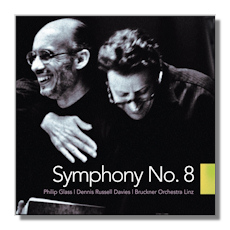
The Internet's Premier Classical Music Source
Related Links
- Glass Reviews
- Latest Reviews
- More Reviews
-
By Composer
-
Collections
DVD & Blu-ray
Books
Concert Reviews
Articles/Interviews
Software
Audio
Search Amazon
Recommended Links
Site News
 CD Review
CD Review
Philip Glass

Symphony #8
Bruckner Orchestra Linz/Dennis Russell Davies
Orange Mountain Music OMM0028 (2006) 38:22
This is a purely instrumental symphony with no connection outside itself. In his notes, Glass writes "the subject of the work is the language of music itself, as in the tradition of the 18th and 19th century symphonies." He does indicate that the formal structure is unusual. The long (nearly twenty minute) first movement has no fewer than eight themes, stated at the beginning. The development "culminates in a series of "stretto-like passages, producing a highly contrapuntal effect. The twelve-minute second movement is a passacaglia, with its harmonic basis sixteen measures long. There are "some extended, at times quite oblique, melodic embellishments." The third (final) movement runs only seven minutes. Glass says "what it lacks in length it makes up in density. The [main] theme, with its accompanying harmony is heard twice, then joined with a counter theme, also heard twice. An extended cadence serves as a coda…" No tempo or expressive directions are given.
The long opening movement begins with emphatic chugging pulsation, with light percussion. It is melodic, with high brass standing out There is some ostinato, but it is not constant. One should remember that there are those eight themes and the contrapuntal treatment which Glass tells us about. The dynamic intensity rises and falls. Some heavy drumming occurs near the end and the music is most complex there. The tempo is steady. It may help some listeners to think of as Glass's inspiration as baroque in origin. He studied Bach for a year with Nadia Boulanger in Paris, as he reports in his recent memoirs. I find the movement -–which comes to a sudden halt – exciting.
The second movement is beautifully melodic, tonal, and with a pace that is moderate – but insistent – with mostly steady rhythm. It begins with the basses firmly establishing the passacaglia theme. Instrumentation is mostly for strings and brass, with a soft solo flute and a long, high trumpet solo. Generally the dynamics are varied – rising and falling. The ending fades to silence.
The finale opens quietly with plaintive woodwind and brass sounds dominant. Phrasing, rather than steady pulsation is certainly what is noticed here. Maybe my listening is either more sophisticated or more naïve than I realize, but I don't hear this final movement as dense, despite the composer's claim. On the other hand, it is certainly not simplistic. Both high and low tones add to the movement's interest. It seems over all too soon.
Highly recommended.
Copyright © 2015, R. James Tobin





















